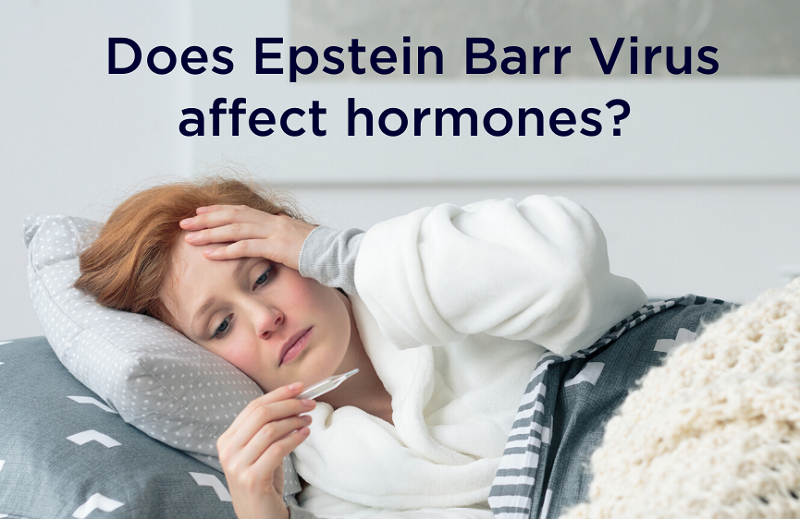Epstein Barr Virus (EPV) & Your Hormones
By Rachel Enright

What is EPV?
The Epstein-Barr Virus (EBV) is part of the herpes family, which is the same group of viruses that can cause cold sores, genital herpes, chickenpox, and shingles. EBV is most known for causing mononucleosis or the “kissing disease.” The virus is transmitted through intimate contact, which includes “sharing” saliva. This can happen through drinking out of the same cups, kissing, sharing straws or even passing cigarettes (one of the reasons EBV is often transmitted in the teenage years).
You may be surprised to know how common EBV is. Up to 95% of US adults have contracted the virus by the age of 40. Most acquire it much earlier as children, teenagers or young adults. Half of all children have it by age 5. Once you have EPV, it may remain dormant for many years and flare up any time, especially during periods of lowered immune function and trauma.
EPV can present in many different ways such as rashes, fevers, flu-like symptoms, aches and pains, sore throat, and swollen lymph nodes. Fertility issues and menstrual irregularities can also be an indication that you have the virus.
What flares up EPV?
Stress, trauma, lowered immunity, poor diet, and environmental factors – all these can cause the EPV virus to act up. Since EBV enters the lymph nodes in the neck and throat, the thyroid is most susceptible to damage. Thus, there is a strong link between EBV and thyroid issues. When the thyroid is affected, the adrenals and endocrine system are also compromised.

EBV is often related to auto-immune disorders such as Hashimotos. Just recently, endometriosis has been categorized as an auto-immune disease – see the potential link? Although more substantial research needs to be done, I believe this is highly likely.
Here are what research and studies have shown so far:
- Links of effects and associations between viruses and estrogen metabolism.
- The Epstein-Barr virus is capable of increasing aromatase, favoring elevations in circulating oestrogen. Aromatase is responsible for the aromatization of androgen into oestrogen, which can result in oestrogen dominance.
- Over 75% of people with autoimmune disease are women.
- The Epstein-Barr virus (EBV) is associated with autoimmune diseases such as Hashimoto’s thyroiditis, Grave’s disease, rheumatoid arthritis, lupus, and Sjögren’s syndrome.
What can you do to fight EBV naturally?
First and foremost, it’s important to know that there are no specific prescribed treatments for Epstein-Barr. However, there are many natural antiviral treatments that you can undertake to help suppress the virus.
- Increase consumption of garlic, ginger and coconut oil.
- Ashwagandha is an adaptogenic healing herb that can help with general immune support.
- Increase antioxidant intake to help rid the body of free radicals.
- CoQ10 may be helpful for fatigue.
- Add in Happy Greens and Happy Turmeric.
- Work with a practitioner who can be more specific with your individual needs.
- Lower your stress levels. When we are chronically overwhelmed and exhausted, the body has to work much harder to fight infection and inflammation.
- Rest and make sure you have adequate restorative sleep.
- Boost your immune function by removing processed foods from your diet and following a whole-food eating plan. Our latest HAPPY HEALTHY YOU book serves as a guide and features over a hundred whole-food recipes that can help fight disease and inflammation.
How do you test for EPV?
Conventional medical tests from your local GP are common and generally reliable for testing for the Epstein-Barr virus. Testing includes getting both a complete EBV acute panel and a chronic infection panel.
Keep in mind that EPV often goes undiagnosed for months or even years. In a significant number of cases, medications such as antidepressants and even HRT were given while the virus remained undetected. Sadly, this does not suppress the actual virus and can even worsen your condition. For this reason, it is generally a good idea to have yourself tested.
REFERENCES
Marci R, Gentili V, Bortolotti D, Lo Monte G, Caselli E, Bolzani S, et al. Presence of HHV-6A in Endometrial Epithelial Cells from Women with Primary Unexplained Infertility. 2016. PLoS ONE. 11(7): e0158304.
https://doi.org/10.1371/journal.pone.0158304
Anette Holck Draborg, Karen Duus, Gunnar Houen. Epstein-Barr Virus in Systemic Autoimmune Diseases. Journal of Immunology Research. 2013. Article ID 535738.
https://doi.org/10.1155/2013/535738
Janegova A, Janega P, Rychly B, Kuracinova K, Babal P. The role of Epstein-Barr virus infection in the development of autoimmune thyroid diseases. Endokrynologia Polska. 2015;66(2):132-6.
https://pubmed.ncbi.nlm.nih.gov/25931043/
Vottero A, Kirschner LS, Yue W, Brodie A, Stratakis CA. P450arom gene expression in peripheral blood lymphocytes: identification of a cryptic splice site for exon-1 after Epstein-Barr virus transformation. The Journal of Steroid Biochemistry & Molecular Biology. 1998. Mar;64(5-6):245-50.
https://pubmed.ncbi.nlm.nih.gov/9618025/








Leave a comment
This site is protected by hCaptcha and the hCaptcha Privacy Policy and Terms of Service apply.